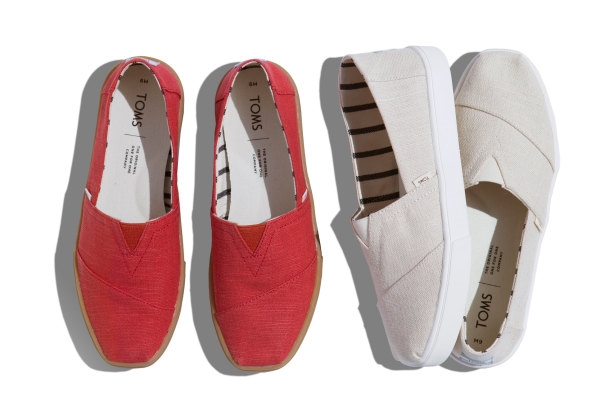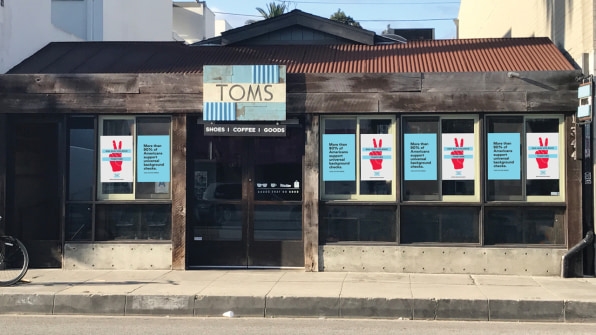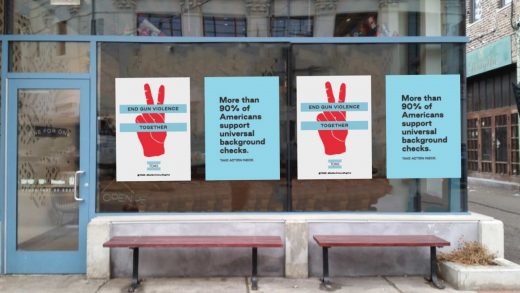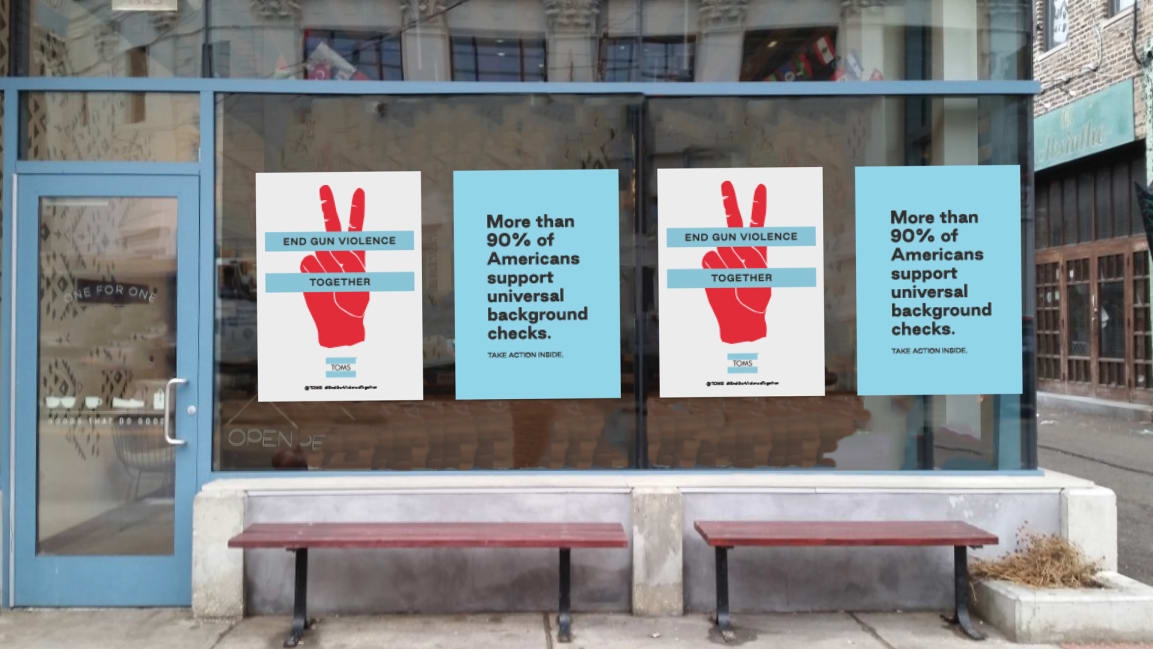Why TOMS is taking a stand to end gun violence
The day after a gunman opened fire at a nightclub in Thousand Oaks, California, on November 8, TOMS founder Blake Mycoskie was in the back seat of a car on the way to his office when his wife, Heather Lang, called. “She was emotional–the shooting was 20 minutes from our house–and she said she wasn’t going to take our [4-year-old] son to school; she didn’t feel safe anymore,” Mycoskie says. “She said she was tired of thoughts and prayers and no action–we had to do something.” He pulled out his laptop in the car and drafted “the most intense email I’ve ever written” to the board of directors at TOMS and to the brand’s CEO, Jim Alling (who took over after Mycoskie stepped down in 2015). In it, he made the case for TOMS taking a stand on ending gun violence–and in the process, overhauling the giving model that made the brand famous in the first place.
Having founded a brand that’s become synonymous for corporate giving and social engagement since it launched in 2006, Mycoskie is highly attuned to pressing societal issues and the role that business can play in finding solutions. TOMS has given shoes to over 86 million people to date through its signature buy-one, give-one model (though the efficacy of using this method to address systemic poverty has been questioned over the years). Through the sale of its sunglasses, the company has helped finance eyesight restorations for 600,000 people, and proceeds from coffee, offered at its retail stores since 2014, have delivered clean water to communities where the beans are grown. Mycoskie remains confident in TOMS’s ability to make an impact in these areas, and cites the brands’ loyal customer base as evidence that people want to support companies that take a stand on social causes.

But delivering shoes to those who don’t have any and restoring eyesight to people who can’t see are missions that are hard to object to. They’re not political. As a brand, TOMS never has been. “I’m a Christian guy from Texas; my belief in starting TOMS was that we have a responsibility to take care of our neighbors,” Mycoskie says. That message has resonated across the political gulf in the U.S.: The company surveys its customer base regularly, and every time, the split comes back even: 50% Democrat, 50% Republican.
Taking a stance in the gun violence debate represents a radically different approach for TOMS, although in Mycoskie’s mind, it’s in line with the company’s original mission. “This is a human issue,” he says. “It’s become political, but ending gun violence is about making a better world, which is what we’ve always been about.”
On November 12, Mycoskie announced his idea to Bain Capital, the private equity firm that’s owned a 50% stake in TOMS since 2014: TOMS would donate $5 million to nonprofits working to end gun violence (including Everytown for Gun Safety, Faith in Action, March for Our Lives, and Moms Demand Action), use its platform and social network to call on lawmakers to pass universal background checks, and permanently alter its giving model to prioritize issue-based efforts of this magnitude going forward. He was done avoiding politics. “If we have this much power as business leaders, we have to use it,” he says.
It was a lot for Bain executives to absorb. They were not opposed, Mycockie says; one of the firm’s partners is among the top contributors to Everytown for Gun Safety, and TOMS’s board had already been meeting with consultants for two years to discuss how the brand could evolve its approach to addressing social issues. But Mycoskie’s End Gun Violence Together initiative presented significant risks for the company.
Gun violence is one of the most polarizing and politicized issues in the U.S. today. Even though studies have found that 90% of Americans support universal background checks, advocacy efforts around ending gun violence tend to get pulled to the extremes. “Any mention of ending gun violence gets spun as, ‘You’re going to take away our guns,’” Mycoskie says. Few brands have taken a leadership position on the issue, and those that have, have faced opposition. When Delta rolled back a pre-existing discount for National Rifle Association members, the Republican-controlled Georgia legislature threatened the airline carrier with cancelling a tax break that was saving them millions on jet fuel. Dicks Sporting Goods, which made a statement explaining why it was tightening its gun sales after the devastating school shooting in Parkland, Florida, lost contracts with firearms companies. Customers in favor of unrestricted access to guns boycotted the companies.
Levi Strauss quietly pledged $1 million in corporate donations in support of ending gun violence in September. When Mycoskie called Levi’s CEO, Chip Bergh, for advice this past week, Bergh told him that engaging on the topic is “a lonely position to take.” He also suggested that Mycoskie line up a security detail for himself. Emotions run high in the gun violence debate, and the risks for high-profile people like Mycoskie who take a stand are significant. Some believe that this is why many country music stars—who arguably would have the most sway in the call to end gun violence–have remained silent on the issue.

There were more practical risks, too, such as branding and sales: Mycoskie was proposing a complete overhaul of TOMS’s website, advertising campaigns, and in-store displays the week before Black Friday and the busiest time of the year for any consumer brand. “We had this whole thing lined up with fluffy slippers for the holidays,” Mycoskie says. He proposed swapping that out for “End Gun Violence Together” imagery, with a link on the website that visitors could click to send a postcard to their elected officials, calling for universal background checks. “We timed it, and it takes 22 seconds,” Mycoskie says. He hoped that “maybe after that, [they’d] decide they like what we’re doing and take a look at the shoes.” It’s not exactly a product-first approach.
While managing his family’s evacuation of their Topanga, California, home due to wildfires, Mycoskie spent the next few days on the phone with his partners at Bain and with his team at TOMS, who pitched in overtime, and last Tuesday, he got the sign-off he needed.
Today, just 12 days after Mycoskie received that phone call from his wife, the TOMS website has been redesigned to promote the End Gun Violence Together initiative. All of TOMS’s in-store displays–from Austin, Texas, to the Mall of America in Minnesota–will amplify the brand’s new direction. The company is bolstering security at retail outposts in more pro-gun regions, and anticipating that some customers will drop the brand entirely. But he’s also hoping the initiative starts a conversation. “We want to educate people that ending gun violence doesn’t mean taking away guns–it starts with passing universal background checks, which would keep domestic abusers, terrorists, and felons from buying weapons,” he says. “Right now, you can be on the terrorist watch list and walk into a store and buy an AR-15. I don’t think anyone thinks that’s a good thing.” He wants the phrase “universal background checks” to lodge in people’s mind as a common-sense goal to keep citizens safe. Meanwhile, the file-sending company WeTransfer has dedicated $1 million in advertising space on its platform to the campaign, which WeTransfer estimates will reach 40 million people during the holidays.
TOMS knows that it’s likely to lose consumers who would rather see the brand steer clear of politics. But Winter Minisee, a 17-year-old from Riverside, California, who helped organize the National Youth Walkout, thinks that the initiative might win the company a new audience. “People are always trying to figure out how to market to young people, but we’re waiting for brands that reflect our needs,” Minisee says. Over 1 million people participated in March for Our Lives, the protest against gun violence that was led primarily by students from Parkland, and 1 million young people walked out of their classrooms during the National School Walkout soon after. In the midterm elections, she says, young people who could vote “turned out in numbers never seen before.” These are the people truly leading the charge on ending gun violence, and Minisee and her fellow youth leaders are energized by companies like TOMS using their political and financial heft to support them.
As for Mycoskie, after a whirlwind seven days of developing and implementing an initiative and a new direction for the company, he’s building out a list of other CEOs and brand leaders he might contact to form a coalition around the issue. But that might be a task for another week. “I’m not going to be calling people up on Thanksgiving Day,” he says.
(64)



